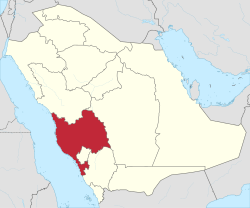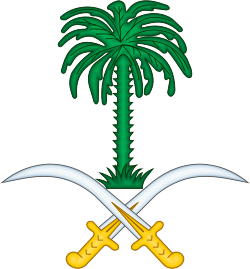Mecca Region
The Makkah al-Mukarrammah Province (Arabic: مِنْطَقَة مَكَّة ٱلْمُكَرَّمَة Minṭaqah Makkah al-Mukarramah), often shortened to Makkah Province and also known as the Makkah Region, is one of the 13 provinces of Saudi Arabia. It is the third largest province by area at 153,128 km2 (59,123 sq mi) and the most populous one with a population of 8,557,766 as of 2017[1], of which 4,041,189 were foreign nationals and 4,516,577 were Saudis.[1] It is located in the historic Hejaz region, and has an extended coastline on the Red Sea. Its capital is Makkah, the holiest city in Islam, and its largest city is Jeddah, which is also Saudi Arabia's main port city. The province accounts for 26.29% of the population of Saudi Arabia[1] and is named after the holy city of Makkah.
Makkah al-Mukarramah منطقة المكة المكرمة | |
|---|---|
| Mintaqah al-Makkah al-Mukarramah | |
.jpg) | |
 Map of Saudi Arabia with Mecca highlighted | |
| Coordinates: 21°30′N 41°0′E | |
| Capital | Makkah |
| Largest city | Jeddah |
| Governorates | List
|
| Government | |
| • Governor | Khalid bin Faisal Al Saud |
| • Deputy Governor | Badr bin Sultan bin Abdulaziz |
| Area | |
| • Total | 153,148 km2 (59,131 sq mi) |
| Population (2017 census) | |
| • Total | 8,557,766 |
| • Density | 56/km2 (140/sq mi) |
| ISO 3166 code | SA-02 |
| Website | www |
Most of the population is concentrated in three cities: Jeddah, Makkah and Ta'if. Jeddah is the largest city in the province and the second-largest in Saudi Arabia with a population of 2,867,446 as of 2020.[2] Makkah is the second-largest city in the province and third-largest in the kingdom at 1,323,624[2]. After the city of Ta'if at third place, Rabigh, Shafa, Turbah and Jumum are other populous cities and towns in the region.[2] The region receives Muslim pilgrims of the Umrah and the Hajj around the year and its population increases by up to 2 million during the Hajj.
The province has approximately 700 kilometres (430 mi) of coastline on the Red Sea and hosts oil refineries in Rabigh, port and oil export facilities in Jeddah and the King Abdullah University of Science and Technology and King Abdullah Economic City besides the holy city of Makkah.
Geography
Most of the central and eastern portions of the province are desert, with the Hejaz mountains, which vary in elevation from 600 meters to 2000 meters, separating the relatively flat Nafud desert and coastal plains. Agriculture takes place in the region's many wadis and oases, with the most commonly-grown crops being dates and barley, alongside other vegetables and fruits.
The region's extended coastline faces Sudan to the west and Eritrea and Ethiopia to the south. The province is bordered by the Madinah Province to the north, the Riyadh Province to the east and the Baha and Aseer provinces to the south.
History
Ancient Mecca was an oasis on the old caravan trade route that linked the Mediterranean world with South Arabia, East Africa, and South Asia. The town was located about midway between Maʾrib in the south and Petra in the north, and it gradually developed by Roman and Byzantine times into an important trade and religious centre. Ptolemy’s inclusion of Macoraba, a city of the Arabian interior, in his Guide to Geography was long held to show that Mecca was known to the Hellenistic world. Since the late 20th century, however, some scholarship has called the identification of Macoraba with Mecca into question.[3]
According to Islamic tradition, Abraham and Ishmael, his son by Hagar, built the Kaʿbah as the house of God. The central point of pilgrimage in Mecca before the advent of Islam in the 7th century, the cube-shaped stone building has been destroyed and rebuilt several times. During pre-Islamic times the region was ruled by a series of Yemeni tribes. Under the Quraysh it became a type of city-state, with strong commercial links to the rest of Arabia, Ethiopia, and Europe. Mecca became a place for trade, for pilgrimage, and for tribal gatherings[3]. The city of Jeddah is believed to have been a fishing hamlet occupied by early Yemeni tribes. The region has held significant religious importance greatly increased with the expeditions of Muhammad in the early 7th century. As the ancient caravan route fell into decline, Mecca lost its commercial significance and has since lived mainly on the proceeds from the annual pilgrimages and the gifts of Muslim rulers.
The city of Makkah was sacked by the Umayyad general al-Ḥajjāj ibn Yūsuf, and thereafter the city, and at the time, the region, acknowledged the power of the Umayyad caliphate at Damascus and, following the eclipse of that dynasty, of the ʿAbbāsid caliphate of Baghdad. The city suffered great indignity at the hands of the Shīʿite Qarmatians in 930 when that sect’s leader Ṭāhir Sulaymān pillaged Mecca and carried off the Black Stone from the Kaʿbah. Beginning in the mid-10th century, the rulers of the city were chosen from the sharifs, or descendants of Muhammad, who retained a strong hold on the surrounding region while often paying homage to stronger political entities. The ability of the sharifs, originally moderate Shīʿites, to adapt to the changing political and religious climate ensured their preeminence in local affairs for the next 1,000 years. In 1269, the region came under the control of the Egyptian Mamlūk sultans. In 1517, dominion over the area passed to the Ottoman Empire, with its capital in Constantinople (now Istanbul). With the Ottoman collapse after World War I, control of Mecca was contested between the sharifs and the House of Saʿūd of central Arabia, adherents to an austere, puritanical form of Islam known as Wahhābism. King Ibn Saʿūd conquered the region in 1925, and the region of Makkah became a province of the Kingdom of Saudi Arabia and the city became the capital of the province.[3]
The region underwent extensive economic development as Saudi Arabia’s petroleum resources were exploited after World War II, and the number of yearly pilgrims to Makkah increased significantly[3].
Demographics
Population
According to the Population Characteristics Surveys conducted by the General Authority of Statistics, the Makkah Province had a population of 8,557,766 as of December 2017, of which 4,516,577 were Saudis and 4,041,189 were foreign nationals. Divided by gender, 4,864,584 were males and 3,693,182 were females. The Makkah Province is the most populous province of Saudi Arabia and it has a population even larger than that of the Riyadh Province. With an estimated population of 4,076,000 as of 2019, Jeddah is the most populous city in the province and the second most populous city in the country. The governorate with the largest population is the Jeddah Governorate. The sex ratio was approximately 132 males per 100 females.
Religion
Censuses in Saudi Arabia do not collect or report data concerning religion. Sunni Islam of the Hanbali school of Islamic jurisprudence is the predominant religion overall in the country, with smaller numbers of Hanafis, Shafi‘is and Malikis. A minority of Shia Muslims is estimated to live within the province, with even smaller numbers of Hindus, Christians and other religious groups, most of whom are expatriates from India and the Philippines, who mostly reside in Jeddah.
Languages
The official language of Saudi Arabia is Arabic. The main regional dialect of the Makkah Province spoken by Saudis is Hejazi Arabic, with a minority of Najdi Arabic speakers in the eastern parts of the region. Saudi Sign Language is the principal language of the deaf community. The large expatriate communities also speak their own languages, the most numerous of which are some of the Indian languages, Filipino/Tagalog, Bengali and Urdu.
Education
From 1,823,598 Saudi male residents above the age of 10, 87.57%, representing 1,596,946 persons had some form of formal education, while 226,652 were illiterate. As for females, from the 1,765,666 residents above the age of 10, 77.28% or 1,364,529 persons were formally educated, while 401,137 were illiterate.
Healthcare
1.15% of the province's Saudi residents, who were above the age of 15, reported some form of disability in 2016, with visual impairment being the most common form of disability, followed by reduced mobility. 107,770 persons reported severe or extreme disability.
Emirs (Governors)
The position of Governor of Makkah Region has been held by the following individuals since 1924[4]:
| Name | Position held | Notes |
|---|---|---|
| Khalid bin Mansour bin Luway
Arabic: خالد بن منصور بن لوي |
1924 | |
| Mohammed bin Abdulrahman bin Faisal
Arabic: محمد بن عبدالرحمن بن فيصل |
1924-25 | |
| Faisal bin Abdulaziz
Arabic: فيصل بن عبدالعزيز |
1925-58 | |
| Mutaib bin Abdulaziz
Arabic: متعب بن عبدالعزيز |
1958-61 | |
| Abdullah bin Sa'ud
Arabic: عبدالله بن سعود |
1961-63 | |
| Mishaal bin Abdulaziz
Arabic: مشعل بن عبدالعزيز |
1963-71 | |
| Fawwaz bin Abdulaziz
Arabic: فواز بن عبد العزيز |
1971-80 | |
| Majid bin Abdulaziz
Arabic: ماجد بن عبدالعزيز |
1980-99 | |
| Abdulmajeed bin Abdulaziz
Arabic: عبدالمجيد بن عبدالعزيز |
1999-2007 | |
| Khalid bin Faisal
Arabic: خالد بن فيصل |
2007-13 | |
| Mishaal bin Abdullah
Arabic: مشعل بن عبدالله |
2013-15 | |
| Khalid bin Faisal
Arabic: خالد بن فيصل |
2015-present | reappointed by order of |
Administrative divisions
The region is divided into 17 Muḥafaẓat (Governorates):[1]
- Al-Kamil (21,419)
- Al-Khurmah (42,223)
- Khulays (56,687)
- Rabigh (92,072)
- Ranyah (45,942)
- Turubah (43,947)
- Adam
- Aredaat
- Moya
- Mesaan
- Bahra
| Name | Arabic Name | Population (2010) |
|---|---|---|
| Jeddah Governorate | أمانة جدة | 3,456,914 |
| City of Makkah | أمانة مكة المكرمة | 1,675,368 |
| Ta'if Governorate | محافظة الطائف | 1,281,613 |
| Qunfudhah Governorate | محافظة القنفذة | 272,424 |
| Lith Governorate | محافظة الليث | 128,529 |
| Jumum Governorate | محافظة الجبيل | 92,222 |
| Rabigh Governorate | محافظة رابغ | 92,072 |
| Khafji Governorate | محافظة الخفجي | 76,279 |
| Ra's Tanura Governorate | محافظة رأس تنورة | 60,750 |
| Abqaiq Governorate | محافظة بقيق | 53,444 |
| Na'iriyah Governorate | محافظة النعيرية | 52,340 |
| Qaryat Al Ulya Governorate | محافظة قرية العليا | 24,634 |
See also
References
- "Population Characteristics surveys" (PDF). General Authority for Statistics (Saudi Arabia). 2017. Retrieved January 7, 2019.
- worldpopulationreview.com https://worldpopulationreview.com/countries/saudi-arabia-population/cities/. Retrieved 2020-04-14. Missing or empty
|title=(help) - "Mecca | History & Pilgrimage". Encyclopedia Britannica. Retrieved 2020-04-14.
- "Emirs of Makkah". Saudi Ministry of Interior. Retrieved May 3, 2012.
External links
- Emirate of Mecca Region Official Website
- A travel through the province of Mecca, Splendid Arabia: A travel site with photos and routes
- Umm Al Qura University in Mecca
- General Authority for Statistics - Kingdom of Saudi Arabia
